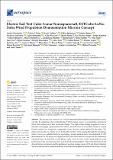Electric Sail Test Cube–Lunar Nanospacecraft, ESTCube-LuNa: Solar Wind Propulsion Demonstration Mission Concept
Author(s)
Slavinskis, Andris; Palos, Mario F.; Dalbins, Janis; Janhunen, Pekka; Tajmar, Martin; Ivchenko, Nickolay; Rohtsalu, Agnes; Micciani, Aldo; Orsini, Nicola; Moor, Karl Mattias; Kuzmin, Sergei; Bleiders, Marcis; Donerblics, Marcis; Ofodile, Ikechukwu; Kütt, Johan; Eenmäe, Tõnis; Allik, Viljo; Viru, Jaan; Halapuu, Pätris; Kristmann, Katriin; Sate, Janis; Briede, Endija; Anger, Marius; Aas, Katarina; Plonis, Gustavs; Teras, Hans; Allaje, Kristo; Vaivads, Andris; Niccolai, Lorenzo; Bassetto, Marco; Mengali, Giovanni; Toivanen, Petri; Iakubivskyi, Iaroslav; Pajusalu, Mihkel; Tamm, Antti; ... Show more Show less
Downloadaerospace-11-00230-v2.pdf (7.492Mb)
Publisher with Creative Commons License
Publisher with Creative Commons License
Creative Commons Attribution
Terms of use
Metadata
Show full item recordAbstract
The electric solar wind sail, or E-sail, is a propellantless interplanetary propulsion system concept. By deflecting solar wind particles off their original course, it can generate a propulsive effect with nothing more than an electric charge. The high-voltage charge is applied to one or multiple centrifugally deployed hair-thin tethers, around which an electrostatic sheath is created. Electron emitters are required to compensate for the electron current gathered by the tether. The electric sail can also be utilised in low Earth orbit, or LEO, when passing through the ionosphere, where it serves as a plasma brake for deorbiting—several missions have been dedicated to LEO demonstration. In this article, we propose the ESTCube-LuNa mission concept and the preliminary cubesat design to be launched into the Moon’s orbit, where the solar wind is uninterrupted, except for the lunar wake and when the Moon is in the Earth’s magnetosphere. This article introduces E-sail demonstration experiments and the preliminary payload design, along with E-sail thrust validation and environment characterisation methods, a cis-lunar cubesat platform solution and an early concept of operations. The proposed lunar nanospacecraft concept is designed without a deep space network, typically used for lunar and deep space operations. Instead, radio telescopes are being repurposed for communications and radio frequency ranging, and celestial optical navigation is developed for on-board orbit determination.
Date issued
2024-03-14Department
Massachusetts Institute of Technology. Department of Earth, Atmospheric, and Planetary SciencesPublisher
MDPI AG
Citation
Aerospace 11 (3): 230 (2024)
Version: Final published version
ISSN
2226-4310
Keywords
Aerospace Engineering